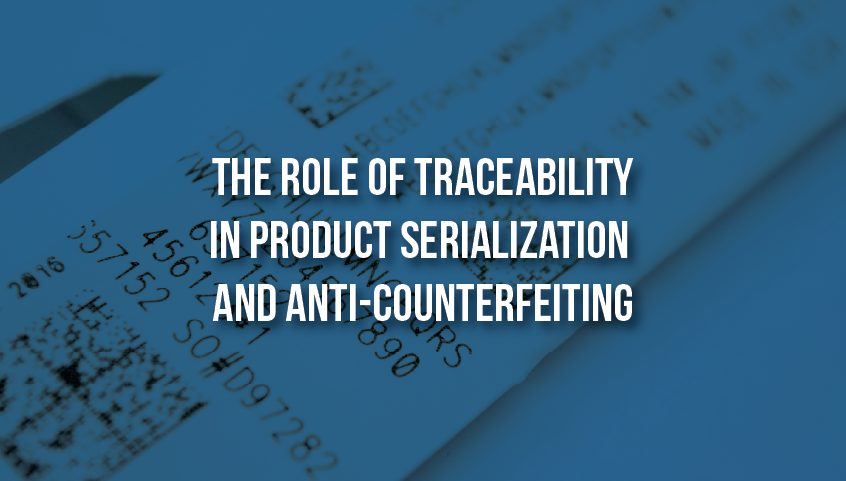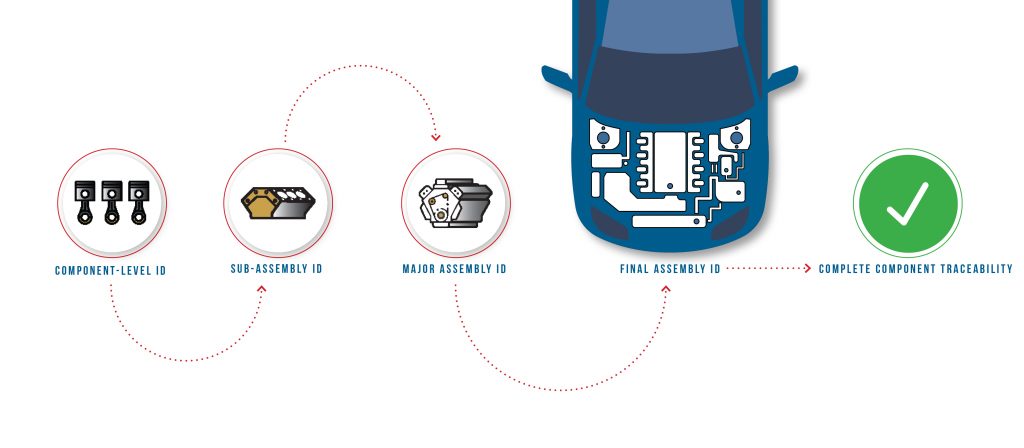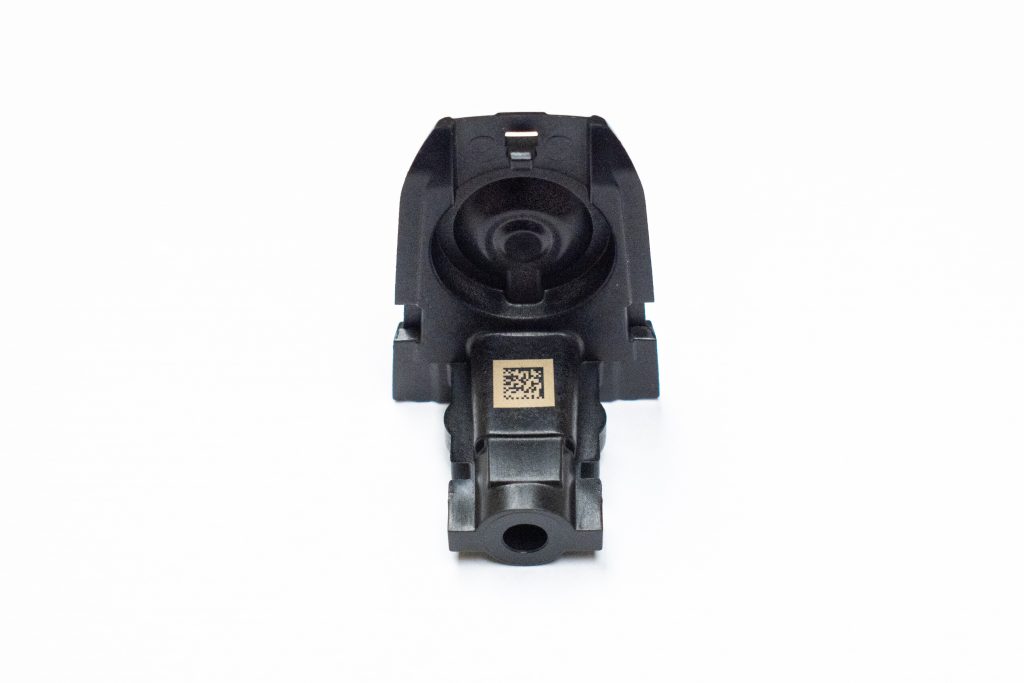| Jul 15, 2025
The Role of Traceability in Product Serialization and Anti-Counterfeiting

In the global supply chain market, manufacturers are facing increasing risks of counterfeit products, gray-market diversion, and regulatory scrutiny. The role of traceability and serialization have become increasingly important in combating these threats, especially in industries where product safety, quality, and compliance are non-negotiable.
Placing permanent marks on parts is now a mainstay in manufacturing. When parts are marked properly, manufacturers can track them throughout their lifecycle, verify their authenticity, and prevent counterfeiting. Laser and dot peen marking technologies are used to make parts easily traceable and play a critical role in serialization and anti-counterfeiting.
Why Part Traceability Matters
Traceability allows manufacturers to capture and track data such as part origin, manufacturing date, serial number, batch number, and production location throughout the entire part lifecycle. Serialization is the process of assigning a unique identifier to each part or product, so manufacturers can trace it back to a database that houses all of the product’s information.

Nearly all industries rely on traceability and serialization, but are most critical in verticals with high safety, regulatory, or counterfeiting risk, such as:
· Automotive
· Aerospace
· Medical device
· Electronics
· Oil & gas
The stakes are high. Counterfeit parts can lead to devastating failures, notably seen in the Takata airbag incident, where counterfeit airbag inflators contributed to serious injuries and deaths. “Counterfeit parts are more than just a failure in quality,” said Bob Stewart, president of the Automotive Anti-Counterfeiting Council, representing North American vehicle manufacturers. “They are a direct risk to safety, where shortcuts in integrity can threaten lives.”
But beyond the human cost, counterfeit and diverted products expose manufacturers to lost revenue, legal risk, warranty claims, and serious reputational damage. In 2024, the U.S. Customs and Border Protection seized more than 7,000,000 counterfeit products totaling over $760 Million MSRP.
Traceability, made possible with secure and permanent marking, is one of the best defenses manufacturers can take to protect themselves and others.
Explore permanent part marking traceability and anti-counterfeiting solutions.
How Laser Marking Supports Serialization & Traceability
For effective traceability, the part must be marked with an identifier that is permanent, machine-readable, and tamper-resistant. Direct part marking (DPM) is carried out through high-contrast laser marking marking technologies.
A traceable mark should have these key qualities:
- Durability: The mark must withstand harsh environments and handling such as heat, cold, chemicals, and abrasion. Labels and ink often won’t hold up against these conditions, but laser marks remain readable throughout the part’s lifecycle.
- Readability: The marks must be high-contrast and offer machine-readable formats such as 2D Data Matrix codes, QR codes, and serial numbers for automated scanning and verification.
- Strategic placement: Marks must be visible and accessible for inspection, yet not interfere with part performance or function. For anti-counterfeiting, covert marks in discrete locations may also be used.

Different part materials present unique challenges. Plastics, metals, ceramics, and composites require tailored marking solutions. MECCO supports this versatility through a broad laser portfolio – including fiber, MOPA, CO2 and UV lasers – enabling manufacturers to mark a wide variety of surfaces with high precision and reliability.
Read A Beginner’s Guide to Laser Marking Systems
Laser Marking At Work:
MECCO helped a multinational electrical equipment manufacturer address gray-market diversion of circuit breakers. Sales teams and retailers were finding products with falsified labels and performance ratings being sold through unauthorized channels, creating risk for the brand and end customers.
By implementing permanent laser marking tied to a secure database – leveraging MECCO’s partnership with iTRACE Technologies – the company improved traceability, reduced production overruns, and gained the ability to detect counterfeit parts in the field.
How Traceability Helps Prevent Counterfeiting
Serialization and traceability through laser and dot peen marking machines play a huge role in preventing bad actors from counterfeiting parts – and make the detection of counterfeit parts much easier. Here’s how:
- Unique identification: Each serialized part carries a permanent DPM mark that can’t be replicated by counterfeiters.
- Tamper resistance: Laser and dot peen marks cannot be easily altered or removed like labels or ink.
- Supply chain visibility: Serialized parts are scanned and verified against the manufacturer’s database at multiple points in the supply chain. If a counterfeit part lacks a matching record or presents a mismatched code, it is flagged.
Advanced marking techniques – such as microscopic marks or covert laser watermarks – add further layers of security. MECCO also integrates with vision systems and partners with technologies like iTRACE to provide additional authentication capabilities.
MECCO’s Role in Building Traceable, Secure Systems
MECCO supports manufacturers at every stage of their traceability, serialization, and anti-counterfeiting initiatives by providing:
- Permanent, high-quality marking: MECCO lasers apply accurate, durable marks on products and components.
- Database integration: MECCO’s Enterprise Integration Platform (EIP) and customizable graphical user interfaces (GUIs) ensure marks are tied to the correct data in the manufacturer’s traceability system.
- Vision verification: Integration with vision systems to verify marks and automatically report back to databases.
- Advanced marking techniques: MECCO is constantly evolving its solutions to stay ahead of counterfeiters by developing covert marking capabilities, expanding its laser portfolio, and collaborating with leading manufacturers to anticipate and counter gray-market threats.
Traceability and serialization are no longer optional. As supply chains grow more complex and counterfeiting tactics become more sophisticated, manufacturers must invest in high-quality parts marking to protect their business.
If your team is exploring ways to strengthen traceability or protect your brand from counterfeit risk, MECCO is ready to help.Contact us today to learn more.
